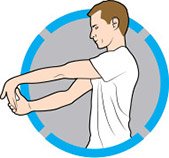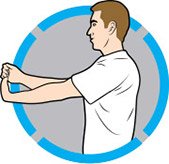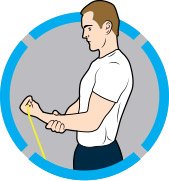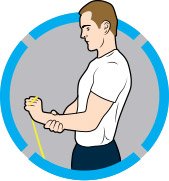The wrist joints are constantly under demand in sports. Falling on your hands after a football tackle or getting hit with a ball can cause a blunt trauma injury to the wrist. Throwing a ball, swinging a club, or landing a punch also stresses the wrist.
The wrist is comprised of eight small bones (carpal bones) plus the two longer bones in your forearm (radius and ulna). The wrist can move in flexion and extension (moving the palm of your hand toward or away from your forearm), as well as abduction and adduction (think of a waving motion). Proper wrist flexibility and stability is important to help prevent injury.
One common wrist problem that can occur from prolonged training is carpal tunnel syndrome (CTS). This occurs when the median nerve, which originates in the upper part of your arm and runs all the way down into the palm of the hand, becomes compressed or irritated. The carpal tunnel is a narrow passageway in the wrist comprised of bones and ligaments, which allow the median nerve to enter the palm.

If the nerve becomes compressed by tendonitis, bone degeneration, or swelling, you can feel pain, tingling, or numbness. The symptoms mostly occur in areas of the palm that include the thumb, the second and third digits, and a slight portion of the fourth digit. This is commonly seen in computer workers from repetition movements during typing.
However, repetitive movements from weight training and exercise that involve the wrist can also cause carpal tunnel syndrome. Persistent hand or finger pain, tingling, or numbness could indicate CTS. If you've experienced this, re-evaluate your activities to reduce stress on your wrist. If changes to help reduce wrist stress do not resolve the problem, you may need to see a health professional. But if you're currently feeling fine—yet perhaps unknowingly placing stress on your wrist—there are preventative steps you can take.
Roughly 4-10 million Americans have suffered from carpal tunnel syndrome.
Preventative Exercises
Here are some recommended stretches and exercises to help prevent wrist problems. Remember, if you experience any pain, tingling, or numbness from these movements, seek a medical evaluation for CTS.

EXERCISE 1 Wrist Extensor Stretch
With your palmed facing up and your elbow straight, pull your hand down with your other hand. You should feel a mild to moderate stretch. Hold for 10-15 seconds. Repeat with your other wrist for three sets.

EXERCISE 2 Wrist Flexor Stretch
Keep your elbow straight and pull your wrist backward with your other hand. You should feel a mild to moderate stretch. Hold for 10-15 seconds. Repeat with the other wrist for three sets.
EXERCISE 3 Tennis Ball Squeeze
Squeeze a tennis ball as hard as possible without causing pain. Hold for 5-10 seconds. Repeat 8-10 times.

EXERCISE 4 Resistance Band Wrist Flexion
Wrap a resistance band around your hand with your palm facing up and your elbow by your side, as if doing a dumbbell curl. Keep the elbow bent to 90 degrees and slowly curl your wrist up, squeezing your hand and forearm muscles. Repeat on the other wrist for three sets with 15 reps.

EXERCISE 5 Resistance Band Wrist Extension
With your elbow by your side, wrap a resistance band around your hand. Keep your palm facing down and your elbow bent at a 90-degree angle, as if doing a reverse curl. Slowly curl your wrist up, squeezing your forearm muscles. Repeat with the other wrist and perform three sets of 10-15 repetitions.

